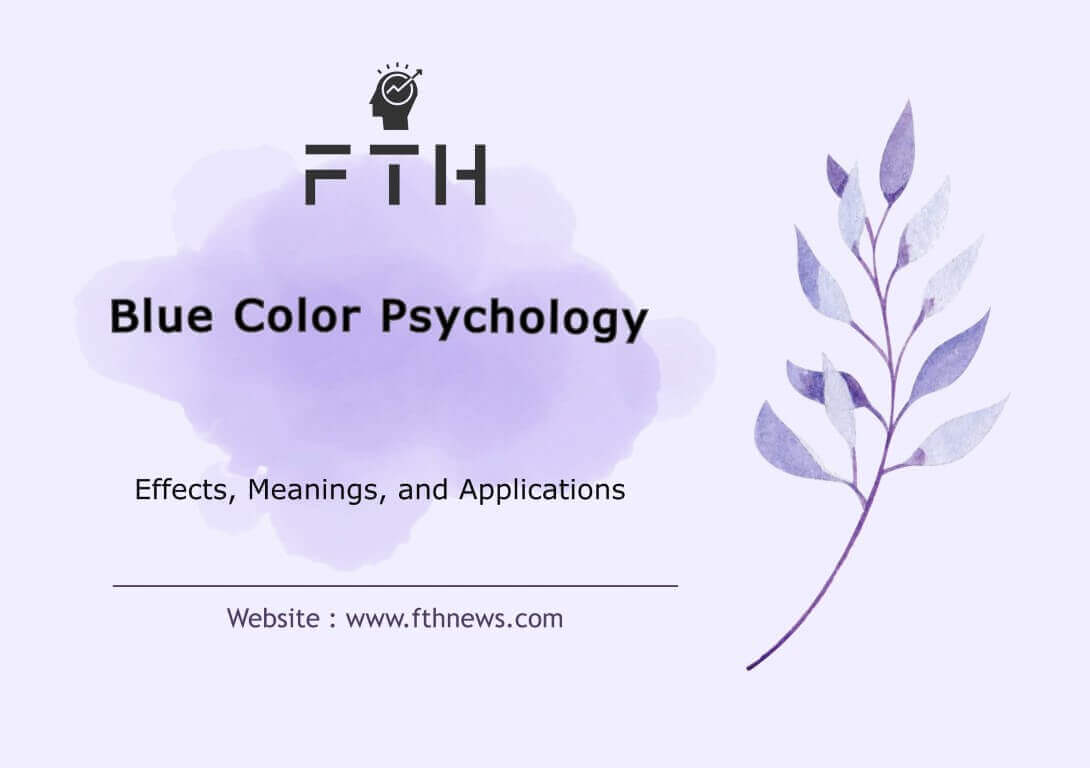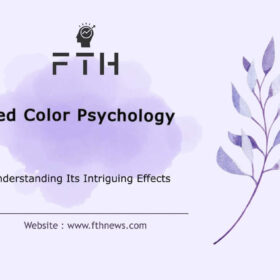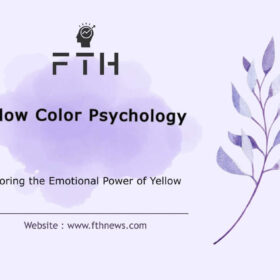
Blue Color Psychology: Color is more than just a visual experience; it has a profound impact on our emotions and behaviors. Among all colors, blue holds a special place. In this blog post, we delve into the intriguing world of blue color psychology, exploring its meanings, effects, applications, and how it influences our daily lives across different fields and cultures.
The Meaning of Blue Color
Blue is one of the most popular colors and is often associated with depth, stability, trust, and calmness. Here are some common interpretations of the color blue:
- Calmness and Serenity: Blue is known to have a calming effect on people. It’s often used in spaces meant for relaxation and peace, like bedrooms and spas.
- Trust and Dependability: Many financial institutions and tech companies use blue in their branding to evoke a sense of trust and reliability.
- Sadness and Melancholy: The term “feeling blue” refers to sadness, showing that blue can also represent deeper, more introspective emotions.
- Intelligence and Efficiency: Blue is often linked to intellect and productivity, making it a popular choice for office spaces.
The Psychological Effects of Blue Color:
Understanding the Blue Color Psychology allows us to harness its power effectively in various aspects of life. Whether creating a serene home environment, designing a productive workspace, or building a trustworthy brand, blue offers a unique blend of calming and motivating properties that can significantly enhance our experiences and interactions.
Blue Color Psychology: Calming Influence
Blue is renowned for its calming properties, which can have a profound impact on both our psychological and physiological states. Research has demonstrated that exposure to blue can lower heart rates, reduce anxiety, and promote a sense of tranquility. This makes blue an ideal color for environments where stress reduction is crucial, such as hospitals, wellness centers, and mental health facilities. In these settings, blue can help create a serene atmosphere that aids in recovery and relaxation. Additionally, using blue in home decor, particularly in bedrooms and living spaces, can foster a peaceful environment conducive to rest and relaxation.
Blue Color Psychology: Enhancing Creativity and Productivity
In workspaces, blue is often employed to boost productivity and focus. The calming influence of blue can help reduce stress and create a more conducive environment for concentration and creative thinking. Studies have shown that people working in blue environments tend to be more productive and make fewer errors. This makes blue an excellent color choice for offices, study areas, and creative spaces where a blend of focus and innovation is needed. By promoting mental clarity and reducing distractions, blue can enhance overall workplace efficiency and encourage innovative problem-solving.
Blue Color Psychology: Building Trust
Blue is a color that naturally engenders trust and reliability. This is why many brands, especially in the tech, finance, and healthcare industries, incorporate blue into their logos and branding materials. Companies like Facebook, Twitter, and LinkedIn use blue to convey a sense of security, stability, and professionalism. The color blue helps to establish a trustworthy image, making customers and users feel more confident and secure in their interactions with these brands. This strategic use of blue in branding helps foster long-term customer loyalty and positive brand perception.
Blue Color Psychology: Promoting a Sense of Security
Beyond trust, blue can also evoke a sense of safety and protection. This is particularly important in industries such as law enforcement and security services. For example, police uniforms often feature dark blue to communicate authority and reliability while also imparting a sense of calm and reassurance to the public. The calming effect of blue, combined with its association with authority, helps to create an environment where individuals feel protected and secure.
Blue Color Psychology: Encouraging Clear Communication
Blue is often associated with clear and effective communication. This is particularly relevant in contexts where transparency and openness are valued. In corporate environments, blue can be used in meeting rooms and collaborative spaces to encourage honest and open dialogue. The association of blue with the throat chakra in Eastern traditions also underscores its link to communication, suggesting that blue can help facilitate better interpersonal interactions and articulate expression.
Blue Color Psychology: Versatility Across Contexts
The psychological effects of blue are versatile, making it suitable for a wide range of applications beyond just calming or productive environments. In educational settings, blue can help students remain focused and calm, enhancing learning outcomes. In retail environments, blue can make customers feel more relaxed and at ease, potentially increasing their willingness to browse and purchase. The broad applicability of blue underscores its powerful and multifaceted impact on human psychology.
Blue Color in Marketing and Branding
Understanding blue color psychology can be a game-changer for businesses. The strategic use of blue in marketing and branding can significantly influence consumer perceptions and behaviors. Here are some ways blue can be effectively used in various industries:
Corporate Branding
Blue is a powerful color in corporate branding because it conveys professionalism, trust, and reliability. It’s a common choice for companies aiming to establish a stable and dependable image. Blue can instill confidence in clients and partners, making it particularly effective for financial institutions, law firms, and corporate enterprises. Brands like IBM and Dell utilize blue to communicate stability and trustworthiness, which are crucial in the corporate world.
Health and Wellness
Light blue shades are often used in health and wellness branding to evoke a sense of calm, cleanliness, and healing. This makes blue an ideal color for hospitals, clinics, and wellness centers. Brands in the health and wellness industry use light blue to create a soothing and reassuring environment, which is essential for patient comfort and trust. For example, healthcare providers like the Mayo Clinic incorporate light blue in their branding to promote a sense of tranquility and care.
Tech and Innovation
Blue’s association with intelligence, efficiency, and innovation makes it a favorite in the tech industry. Tech giants such as Facebook, Twitter, and LinkedIn use blue to convey a message of reliability and forward-thinking. The color blue helps to position these companies as trustworthy and innovative, appealing to users who value security and cutting-edge technology. Blue’s presence in tech branding is a testament to its ability to instill confidence in digital products and services.
Retail and Customer Experience
In the retail sector, blue can influence customer behavior by creating a sense of calm and inviting ambiance. Stores painted in shades of blue can make customers feel more relaxed and comfortable, potentially increasing the time they spend shopping and their overall satisfaction. Retail brands that aim to create a serene and pleasant shopping experience often incorporate blue into their store designs and marketing materials.
Professional Services
Professional service providers, such as consultants, accountants, and legal advisors, use blue to communicate their expertise and dependability. Blue is an excellent choice for business cards, websites, and promotional materials as it projects an image of competence and reliability. This helps to build trust with clients who are seeking knowledgeable and dependable partners.
Different Shades of Blue and Their Meanings
Not all blues are created equal. Different shades of blue can evoke different feelings and responses, each suitable for different marketing and branding purposes:
- Light Blue: Associated with health, healing, tranquility, and softness. It is perfect for health and wellness brands, promoting a sense of calm and care.
- Dark Blue: Represents knowledge, power, integrity, and seriousness. Ideal for corporate and professional settings, dark blue conveys authority and reliability.
- Sky Blue: Conveys freedom, imagination, and inspiration. It is often used in travel and creative industries to evoke a sense of openness and creativity.
- Navy Blue: Symbolizes authority, trust, and confidence. Frequently used by law enforcement and corporate entities, navy blue communicates professionalism and strength.
Practical Applications
- Brand Identity: Incorporating blue into logos, websites, and marketing materials can help create a cohesive and trustworthy brand identity. The use of blue should align with the brand’s values and the emotions it aims to evoke in its audience.
- Advertising: Blue can be used in advertisements to attract attention and create a memorable impression. It is particularly effective in digital marketing, where blue tones can make content stand out on social media platforms.
- Product Packaging: Blue packaging can convey quality and reliability, making products more appealing to consumers. It can be especially effective for tech gadgets, health products, and premium goods.
The Effect of Blue Color on the Human Body
The tranquility of blue extends beyond psychological influences; it also has tangible effects on our physical state:
Lowers Blood Pressure
Research has shown that blue can help reduce blood pressure and calm the heart rate. This physiological response is due to blue’s calming effect on the autonomic nervous system, making it an excellent choice for medical facilities and relaxation spaces where reducing stress is a priority.
Cooling Effect
Blue can make environments feel cooler. This perception of coolness makes blue a popular color choice in regions with hot climates. Blue hues are often used in interior design to create a refreshing and comfortable atmosphere, helping to alleviate the oppressive heat.
Sleep and Relaxation
Exposure to blue light before bedtime can influence sleep patterns. While too much blue light from screens can disrupt sleep by inhibiting melatonin production, blue’s association with calm and relaxation can improve sleep quality in controlled lighting environments. Soft blue lighting and blue-themed decor can create a restful ambiance conducive to better sleep.
Blue Personality Traits
People with a “blue personality” often exhibit distinct traits and behaviors that reflect the color’s characteristics:
Optimism and Sensitivity
Individuals with a blue personality are typically optimistic and sensitive. They are compassionate and empathetic, often going out of their way to help others and build meaningful connections.
Self-Confidence and Loyalty
Blue personalities are known for their self-confidence and loyalty. They value deep, lasting relationships and are reliable and trustworthy partners in both personal and professional settings.
Calmness and Responsibility
These individuals are calm, responsible, and diligent. They handle stress well and are often seen as dependable and capable in various situations.
Honesty and Integrity
Blue personalities are honest and transparent, revealing their true intentions and maintaining high moral standards. Their integrity earns them respect and trust from others.
Introversion and Reflectiveness
Many people with blue personalities are introspective and reflective. They spend a significant amount of time analyzing their thoughts and feelings, which can make them appear reserved or introverted.
Stubbornness and Reluctance to Change
While they value stability and predictability, blue personalities can also be stubborn and resistant to change. They prefer to stick to familiar routines and may struggle with adapting to new situations.
Blue Color in Fashion
The color of our clothes often reveals much about our inner selves. Blue in fashion can communicate reliability, professionalism, and confidence. Wearing blue to a business meeting or interview conveys a sense of loyalty, calmness, and success. It is a popular choice for corporate attire, symbolizing a professional and trustworthy demeanor.
Blue Color in Spirituality
In Eastern mysticism, blue is associated with the throat chakra (normal blue) and the third eye chakra (indigo). These chakras are linked to communication, intuition, and spiritual insight.
Normal Blue
- Throat Chakra (Visuda): Located in the throat, this chakra is associated with speaking and hearing abilities, influencing clear communication and self-expression.
- Gemstones: Turquoise, aquamarine, lapis lazuli, sodalite, quartz, angelite, aura.
Indigo
- Third Eye Chakra (Ajna): Located between the eyebrows, this chakra connects us with intuition and the unconscious mind, facilitating spiritual insight and inner wisdom.
- Gemstones: Amethyst, moonstone, ajilite.
Negative Aspects of Blue:
Sadness and Melancholy:
The phrase “feeling blue” is often used to describe feelings of sadness or melancholy, associating blue with emotional distress.
Coldness and Isolation:
In certain contexts, blue can be perceived as cold or distant, potentially creating feelings of isolation or detachment.
Apathy and Lack of Energy:
Excessive use of blue or certain shades of blue may convey a sense of apathy or lack of energy.
Depersonalization:
Blue can sometimes be seen as impersonal or unemotional, lacking warmth or intimacy.
Rigidity and Conformity:
In some cases, blue may symbolize rigidity or conformity, suggesting a reluctance to change or innovate.
It’s important to note that the interpretation of colors, including blue, can vary widely depending on individual experiences, cultural backgrounds, and personal preferences. While blue is often associated with positive qualities like calmness and trust, it can also have negative associations depending on the context in which it is perceived.
Conclusion
Blue color psychology reveals the profound impact this color has on our emotions, behaviors, and decisions. By understanding and utilizing the power of blue, you can create environments, brands, and experiences that resonate deeply with people. Whether in personal spaces or professional settings, blue’s calming and trustworthy qualities make it a timeless and effective choice.
Embrace the power of blue and transform your world with its serene and reliable energy.














